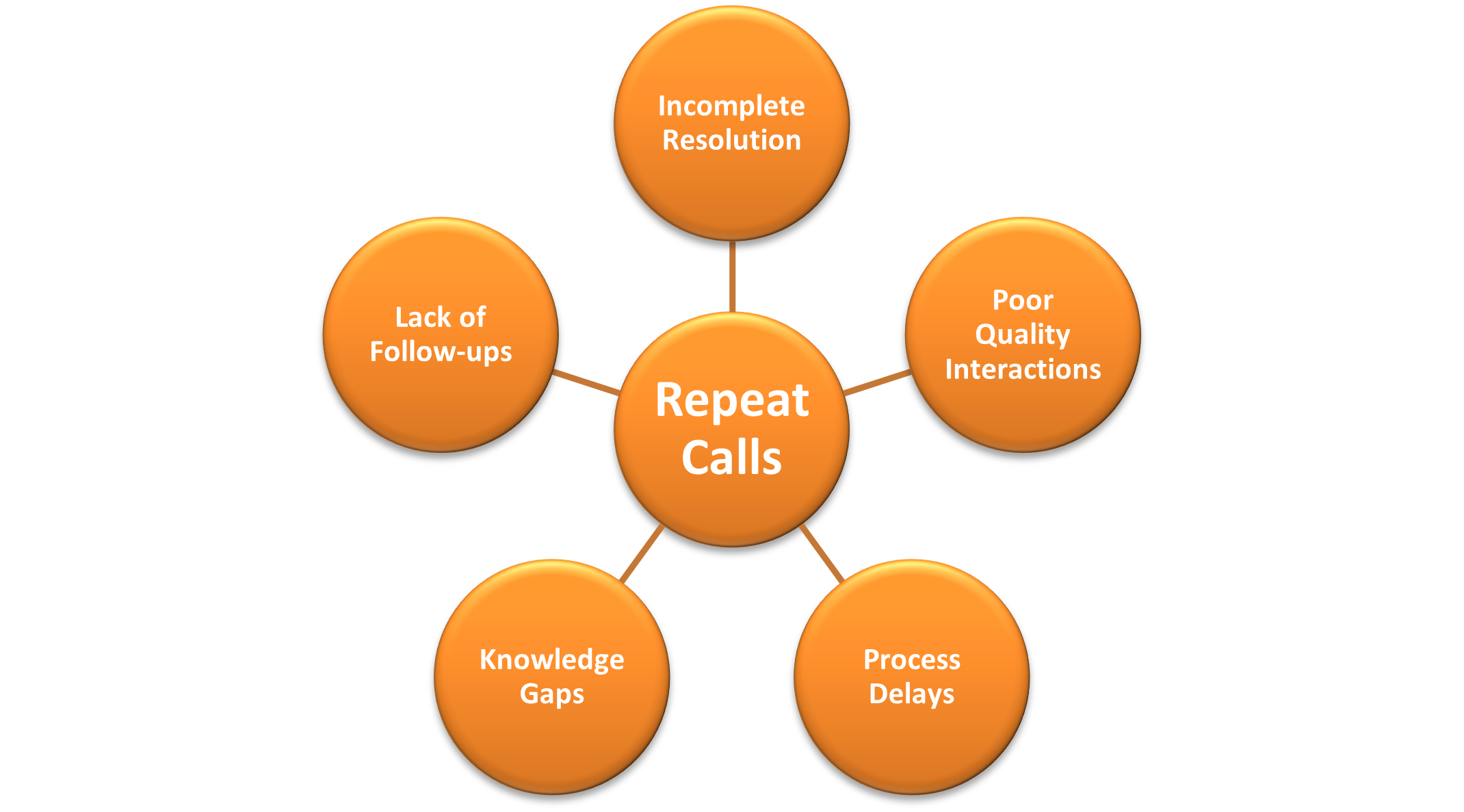Summary
Every customer has some other essential things to go to. They want to avoid spending time arguing with the call center agents or waiting hours on a helpline. Irritated customers are not considered a good sign for a business; therefore, customers must be provided with timely and quick resolution of their issues.
Introduction
Today, customers want quick and fast resolutions of their issues. For this, customer support teams have to ensure that customers’ problems are handled and resolved in the first agent-customer interactions. The reason behind repeated calls is that the customers’ problems still need to be resolved, or the desired assistance needs to be provided to them. It becomes monotonous for customers and call center agents to interact about the same issues repeatedly.
This blog provides an understanding of repeat calls, its causes, and how to track them. It also delves into the ways to reduce repeat calls.
“As per Research and Markets, the global call center was valued at USD 31.97 billion as of 2025 and is expected to grow at a rate of 8.33% to reach USD 47.61 billion by 2030.”

Understanding and Meaning
Repeat Calls (RCs)
RCs are the calls that customers make to get their issues resolved for the same problem more than once. Such situations occur when customers’ queries are not resolved in the first go.
“McKinsey & Co’s ‘Where is customer care in 2024?’ article reported that only 11% of the companies say minimizing contact volumes is essential for them ”
What Causes Repeat Calls?
There are various reasons for RCs, which are:

How Companies Track Them
Call centers can measure repeat calls in the following ways:
Repeat Calls: “Number of Repeat Calls/Total Number of Calls”
Repeat calls and first call resolution (FCR) are different sides of the same coin; companies can track repeat calls by:
“Total number of calls-FCR”
“GetVoip’s ‘Call Center Workforce Management: Benefits, KPIs & Tips’ article states the global average FCR ranges between 70% and 75%”
A high rate means that the operations and interactions need improvements, and companies implement effective training programs and adopt advanced technologies.
Why Reducing Repeat Calls in Call Centers Is Critical?
Repeated calls are a sign of a low satisfaction rate and low conversion rate and lead to a falling customer retention rate. For a growing call center business, improving first-call resolution is its primary goal to reduce repeated calls.
It becomes vital to reduce such calls, and some of the effective methods to accomplish that objective are:
Connect Customers with the Right Agent from the Start
Identifying the precise reason for the customer’s call before matching the request with the appropriate agent is essential. This is a crucial stage in call centers’ repetitive call reduction strategies. In this digital era, most businesses have implemented digital tools like Interactive Voice Response (IVR), etc., to find the appropriate agents for customers’ issues.
Customers eventually grow impatient if all their complaints must be satisfactorily addressed, increasing the number of repeated calls the customer service team receives. Proper routing and resolution are also essential to elevate customer happiness and retention. To accomplish this, call centers need to appoint well-skilled employees or implement digital tools for effective call routing.
Repeated calls frequently stem from a problem that agents are unable to resolve. Call center agents must highlight the causes of the client’s repeated requests for assistance. The management/leadership team reviews the recorded calls to determine the reasons for the repeated calls. Then, such reasons are communicated to the agents, and specialized training is provided. Once agents are aware of what the consumer needs, they can provide prompt assistance, reducing the number of difficult calls from customers.
“Census article ‘Repeat Contact Rate Measuring Customer Interaction’ states that repeat call rates below 5% are considered excellent”
Implement Ongoing Agent Training Programs
The management/leadership team must create effective general and specialized training strategies. Available training is provided to each agent at the beginning of the appointment. However, technical training is offered to improve the agents’ skills continuously.
Such training is provided based on the agents’ skill sets or the arising issues. Training offers an overview of how to respond to customers and resolve their problems once and for all. Once the issues are resolved, the repeated calls tend to decrease.
Create Self-Service Options
You might not have realized it, but various customers want to solve their general queries on their own. This also minimizes the overall repeat calls. Businesses can:
- Create User-Friendly FAQ Pages: Customers can find helpful information on the website’s FAQ page, which can be accomplished by updating the information, adding links to the appropriate sites, and removing old information.
- Establish Digital Assistance: Implement chatbots or AI assistants that provide instant solutions.
- Suggest Help Topic: Track self-service articles or trending articles to promote self-help options and minimize repeat calls.
“On average, SQM Group’s ‘First Call Resolution (FCR): A Comprehensive Guide’ article reported 69% as an aggregate FCR benchmark across all the industries ”
Create a Centralized Knowledge Base for Agents
There are several occasions when call center agents cannot resolve a new issue satisfactorily. Sometimes, the agents seek help from their supervisors and look for answers. The business must have a place where the agents can look for answers. Businesses must create a knowledge center as a hub where call agents can look up the answers and contribute to policies.
Businesses frequently use knowledge centers, which it later classifies as organizational knowledge assets. In addition to receiving training, agents should have access to a resource center with opportunities for problem-solving and sharing solutions with other team members. This allows them to provide appropriate assistance to the customers instead of rushing the clients off the call.
Conduct Post-Call Follow-Ups to Ensure Resolution
After assistance is provided to the customers, it is significant that post-call check-ups are conducted. Such check-ups give the businesses an overview of the interaction, the status of the issues (resolved or not), and so on. Such calls or check-ups not only show the agents’ performance but also that of the overall business.
These check-ups can be used to monitor and highlight the areas of improvement. If necessary, a callback to the customer on their preferred channel can be made to finish the post-call process. Once the process is completed, the leadership team can work on specific strategies to improve the operations, reducing repeated calls.
Conclusion: Repeated Calls Impact Business Growth
Customer satisfaction holds an important place in the growth of call centers. Repeated calls are the indicators of unsatisfied customers, which have an impact on the business as well. Such calls increase the operating costs, negatively impact the brand name, and can also affect the future growth of the business. So, the above-mentioned methods help the company improve call center metrics, provide practical solutions, and reduce repeated calls.
Frequently Asked Questions Repeat Calls in Call Centers
1. What are the business impacts of high repeat calls?
High repeat call rates are influenced by various factors, including:
- Low customer retention rate
- Negative marketing
- High operating costs
- Low agent morale
- Slow growth rate
2. Define knowledge base and why it is required?
It is a centralized repository that includes policies, guidelines, and best practices. This repository can be referred by agents to quickly resolve the complex issues.
3. What is First-Call Resolution (FCR)?
FCR is the total calls resolved in the first interaction itself. A high FCR rate can lead to repeat call reduction, minimized costs, and an improved satisfaction rate.
4. How repeat calls can be reduced by IVR or digital routing tools?
IVR can identify the customer’s issues and forward the calls to the qualified agents, ultimately reducing hold time and callbacks.
5. Why post-call follow-ups are essential?
It is crucial to check whether customers are satisfied with the solutions provided by the agents. By this, customers feel that they are valued, ultimately improving the satisfaction rate and minimizing repeat calls.
Sources:
- Call Centres Market by Channel Type, Deployment Model, Organization Size, Industry Vertical – Global Forecast to 2030.
- Where is customer care in 2024?
- Call Center Workforce Management: Benefits, KPIs & Tips
- Repeat Contact Rate Measuring Customer Interaction
- First Call Resolution (FCR): A Comprehensive Guide



